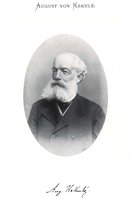Kekulé, August (Society & Environment)

Kekulé, August
| Topics: |
In 1858 August Kekulé von Stradonitz (1829–1896) and Archibald Scott Couper (1831–1892), two young men from different backgrounds—and, as it turned out, entering upon even more disparate career paths—independently recognized that carbon atoms can link directly to one another to form carbon chains. This finding explained the very multiplicity of carbon compounds that had been puzzling chemists. The discovery by these two scientists depended on Kekulé's theory, proposed in 1857, that carbon is tetravalent—valence being defined at the time as the combining capacity of the elements. Couper, in a paper, indicated valence bonds as straight lines linking the symbols for the elements, which is still the practice in most modern structural diagrams.
Kekulé, a German of Czech descent, was intended by his family to become an architect, but at the University of Giessen he was lured to chemistry by Liebig's lectures. Kekulé's paper describing carbon linkage was published in Liebig's Annalen der Chemie und Pharmacie. During his studies he also worked in Paris with Charles Gerhardt, another leading chemist in the effort to understand the constitution of organic compounds. Kekulé, after receiving his doctorate from Giessen, served as a research assistant, first in Switzerland, then in England. On a bus ride in London on the way home from visiting a chemist friend, Kekulé envisioned his earliest notion of carbon chains. In a daydream he "saw" carbon atoms joining in a "giddy dance."
Kekulé returned to Germany from England to begin his career as a university teacher, which took him from the University of Heidelberg, to the University of Ghent in Belgium, and finally to the University of Bonn, where he oversaw the establishment of a chemical institute. He was a good lecturer, well liked by his many students. As with several other scientists in chemical history, writing a textbook—Lehrbuch der organischen Chemie—proved to be a stimulus for new chemical theories. One afternoon in 1865 in Ghent, while he was working on his textbook, he became sleepy and turned his chair to the fire. Again he saw dancing strings of carbon atoms, but this time he saw one that, snake-like, took its tail into its mouth, which gave him the idea for the ring form of the benzene molecule. Here then was a structure for the many molecules that would not fit into the existent structural theory.
Further Reading